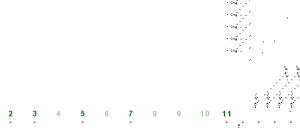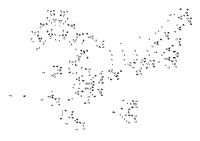Primer
Primer is a pattern that was constructed by Dean Hickerson on November 1, 1991 that produces a stream of lightweight spaceships representing prime numbers. N is prime if and only if a lightweight spaceship escapes to the left of the pentadecathlon at the bottom-left corner of the pattern at generation 120N+100.[1][2] It was the first pattern created that computes prime numbers, though others have since been constructed using the same ideas (see glider gunless primer).
| Primer | |||
| |||
| View static image | |||
| Pattern type | Miscellaneous | ||
|---|---|---|---|
| Number of cells | 2953 | ||
| Bounding box | 440×294 | ||
| Discovered by | Dean Hickerson | ||
| Year of discovery | 1991 | ||
| |||
It works by using gliders to emulate a prime number sieve. Lightweight spaceships that move westward are deleted by gliders that represent positive integers if the lightweight spaceship represents a multiple of that number.
Image gallery
 The stream of spaceships representing prime numbers |
Videos
gollark: What do you mean "arbitrary polls"?
gollark: I have been accused of this. But never actually diagnosed, so things.
gollark: Oh no. I didn't plan for this.
gollark: That's very mean to my alts and I want you to apologize IMMEDIATELY.
gollark: My ~26 alts all asked invisibly.
References
- PRIMES.LIF from Alan Hensel's lifep.zip pattern collection. Accessed on July 28, 2009.
- four-primers.rle.gz from Golly's built-in pattern catalogue. Accessed on July 28, 2009.
This article is issued from Conwaylife. The text is licensed under Creative Commons - Attribution - Sharealike. Additional terms may apply for the media files.
